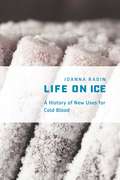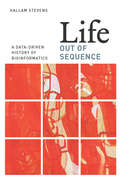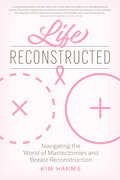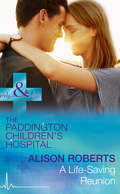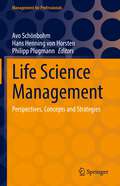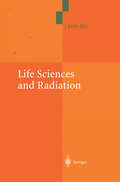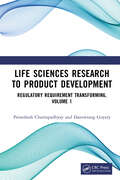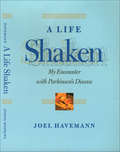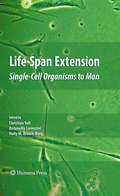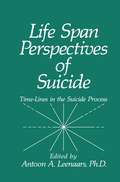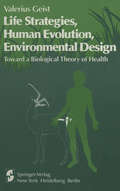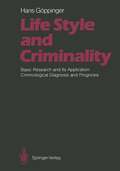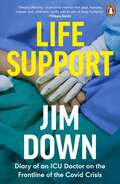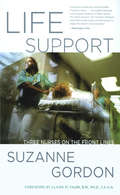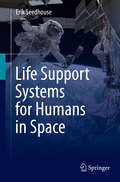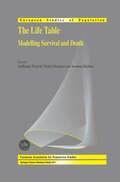- Table View
- List View
Life on Ice: A History of New Uses for Cold Blood
by Joanna RadinAfter the atomic bombing at the end of World War II, anxieties about survival in the nuclear age led scientists to begin stockpiling and freezing hundreds of thousands of blood samples from indigenous communities around the world. These samples were believed to embody potentially invaluable biological information about genetic ancestry, evolution, microbes, and much more. Today, they persist in freezers as part of a global tissue-based infrastructure. In Life on Ice, Joanna Radin examines how and why these frozen blood samples shaped the practice known as biobanking. The Cold War projects Radin tracks were meant to form an enduring total archive of indigenous blood before it was altered by the polluting forces of modernity. Freezing allowed that blood to act as a time-traveling resource. Radin explores the unique cultural and technical circumstances that created and gave momentum to the phenomenon of life on ice and shows how these preserved blood samples served as the building blocks for biomedicine at the dawn of the genomic age. In an era of vigorous ethical, legal, and cultural debates about genetic privacy and identity, Life on Ice reveals the larger picture—how we got here and the promises and problems involved with finding new uses for cold human blood samples.
Life on Ice: A History of New Uses for Cold Blood
by Joanna RadinAfter the atomic bombing at the end of World War II, anxieties about survival in the nuclear age led scientists to begin stockpiling and freezing hundreds of thousands of blood samples from indigenous communities around the world. These samples were believed to embody potentially invaluable biological information about genetic ancestry, evolution, microbes, and much more. Today, they persist in freezers as part of a global tissue-based infrastructure. In Life on Ice, Joanna Radin examines how and why these frozen blood samples shaped the practice known as biobanking. The Cold War projects Radin tracks were meant to form an enduring total archive of indigenous blood before it was altered by the polluting forces of modernity. Freezing allowed that blood to act as a time-traveling resource. Radin explores the unique cultural and technical circumstances that created and gave momentum to the phenomenon of life on ice and shows how these preserved blood samples served as the building blocks for biomedicine at the dawn of the genomic age. In an era of vigorous ethical, legal, and cultural debates about genetic privacy and identity, Life on Ice reveals the larger picture—how we got here and the promises and problems involved with finding new uses for cold human blood samples.
Life on Ice: A History of New Uses for Cold Blood
by Joanna RadinAfter the atomic bombing at the end of World War II, anxieties about survival in the nuclear age led scientists to begin stockpiling and freezing hundreds of thousands of blood samples from indigenous communities around the world. These samples were believed to embody potentially invaluable biological information about genetic ancestry, evolution, microbes, and much more. Today, they persist in freezers as part of a global tissue-based infrastructure. In Life on Ice, Joanna Radin examines how and why these frozen blood samples shaped the practice known as biobanking. The Cold War projects Radin tracks were meant to form an enduring total archive of indigenous blood before it was altered by the polluting forces of modernity. Freezing allowed that blood to act as a time-traveling resource. Radin explores the unique cultural and technical circumstances that created and gave momentum to the phenomenon of life on ice and shows how these preserved blood samples served as the building blocks for biomedicine at the dawn of the genomic age. In an era of vigorous ethical, legal, and cultural debates about genetic privacy and identity, Life on Ice reveals the larger picture—how we got here and the promises and problems involved with finding new uses for cold human blood samples.
Life Out of Sequence: A Data-Driven History of Bioinformatics
by Hallam StevensThirty years ago, the most likely place to find a biologist was standing at a laboratory bench, peering down a microscope, surrounded by flasks of chemicals and petri dishes full of bacteria. Today, you are just as likely to find him or her in a room that looks more like an office, poring over lines of code on computer screens. The use of computers in biology has radically transformed who biologists are, what they do, and how they understand life. In Life Out of Sequence, Hallam Stevens looks inside this new landscape of digital scientific work. Stevens chronicles the emergence of bioinformatics—the mode of working across and between biology, computing, mathematics, and statistics—from the 1960s to the present, seeking to understand how knowledge about life is made in and through virtual spaces. He shows how scientific data moves from living organisms into DNA sequencing machines, through software, and into databases, images, and scientific publications. What he reveals is a biology very different from the one of predigital days: a biology that includes not only biologists but also highly interdisciplinary teams of managers and workers; a biology that is more centered on DNA sequencing, but one that understands sequence in terms of dynamic cascades and highly interconnected networks. Life Out of Sequence thus offers the computational biology community welcome context for their own work while also giving the public a frontline perspective of what is going on in this rapidly changing field.
Life Out of Sequence: A Data-Driven History of Bioinformatics
by Hallam StevensThirty years ago, the most likely place to find a biologist was standing at a laboratory bench, peering down a microscope, surrounded by flasks of chemicals and petri dishes full of bacteria. Today, you are just as likely to find him or her in a room that looks more like an office, poring over lines of code on computer screens. The use of computers in biology has radically transformed who biologists are, what they do, and how they understand life. In Life Out of Sequence, Hallam Stevens looks inside this new landscape of digital scientific work. Stevens chronicles the emergence of bioinformatics—the mode of working across and between biology, computing, mathematics, and statistics—from the 1960s to the present, seeking to understand how knowledge about life is made in and through virtual spaces. He shows how scientific data moves from living organisms into DNA sequencing machines, through software, and into databases, images, and scientific publications. What he reveals is a biology very different from the one of predigital days: a biology that includes not only biologists but also highly interdisciplinary teams of managers and workers; a biology that is more centered on DNA sequencing, but one that understands sequence in terms of dynamic cascades and highly interconnected networks. Life Out of Sequence thus offers the computational biology community welcome context for their own work while also giving the public a frontline perspective of what is going on in this rapidly changing field.
Life Out of Sequence: A Data-Driven History of Bioinformatics
by Hallam StevensThirty years ago, the most likely place to find a biologist was standing at a laboratory bench, peering down a microscope, surrounded by flasks of chemicals and petri dishes full of bacteria. Today, you are just as likely to find him or her in a room that looks more like an office, poring over lines of code on computer screens. The use of computers in biology has radically transformed who biologists are, what they do, and how they understand life. In Life Out of Sequence, Hallam Stevens looks inside this new landscape of digital scientific work. Stevens chronicles the emergence of bioinformatics—the mode of working across and between biology, computing, mathematics, and statistics—from the 1960s to the present, seeking to understand how knowledge about life is made in and through virtual spaces. He shows how scientific data moves from living organisms into DNA sequencing machines, through software, and into databases, images, and scientific publications. What he reveals is a biology very different from the one of predigital days: a biology that includes not only biologists but also highly interdisciplinary teams of managers and workers; a biology that is more centered on DNA sequencing, but one that understands sequence in terms of dynamic cascades and highly interconnected networks. Life Out of Sequence thus offers the computational biology community welcome context for their own work while also giving the public a frontline perspective of what is going on in this rapidly changing field.
Life Out of Sequence: A Data-Driven History of Bioinformatics
by Hallam StevensThirty years ago, the most likely place to find a biologist was standing at a laboratory bench, peering down a microscope, surrounded by flasks of chemicals and petri dishes full of bacteria. Today, you are just as likely to find him or her in a room that looks more like an office, poring over lines of code on computer screens. The use of computers in biology has radically transformed who biologists are, what they do, and how they understand life. In Life Out of Sequence, Hallam Stevens looks inside this new landscape of digital scientific work. Stevens chronicles the emergence of bioinformatics—the mode of working across and between biology, computing, mathematics, and statistics—from the 1960s to the present, seeking to understand how knowledge about life is made in and through virtual spaces. He shows how scientific data moves from living organisms into DNA sequencing machines, through software, and into databases, images, and scientific publications. What he reveals is a biology very different from the one of predigital days: a biology that includes not only biologists but also highly interdisciplinary teams of managers and workers; a biology that is more centered on DNA sequencing, but one that understands sequence in terms of dynamic cascades and highly interconnected networks. Life Out of Sequence thus offers the computational biology community welcome context for their own work while also giving the public a frontline perspective of what is going on in this rapidly changing field.
Life Out of Sequence: A Data-Driven History of Bioinformatics
by Hallam StevensThirty years ago, the most likely place to find a biologist was standing at a laboratory bench, peering down a microscope, surrounded by flasks of chemicals and petri dishes full of bacteria. Today, you are just as likely to find him or her in a room that looks more like an office, poring over lines of code on computer screens. The use of computers in biology has radically transformed who biologists are, what they do, and how they understand life. In Life Out of Sequence, Hallam Stevens looks inside this new landscape of digital scientific work. Stevens chronicles the emergence of bioinformatics—the mode of working across and between biology, computing, mathematics, and statistics—from the 1960s to the present, seeking to understand how knowledge about life is made in and through virtual spaces. He shows how scientific data moves from living organisms into DNA sequencing machines, through software, and into databases, images, and scientific publications. What he reveals is a biology very different from the one of predigital days: a biology that includes not only biologists but also highly interdisciplinary teams of managers and workers; a biology that is more centered on DNA sequencing, but one that understands sequence in terms of dynamic cascades and highly interconnected networks. Life Out of Sequence thus offers the computational biology community welcome context for their own work while also giving the public a frontline perspective of what is going on in this rapidly changing field.
Life Out of Sequence: A Data-Driven History of Bioinformatics
by Hallam StevensThirty years ago, the most likely place to find a biologist was standing at a laboratory bench, peering down a microscope, surrounded by flasks of chemicals and petri dishes full of bacteria. Today, you are just as likely to find him or her in a room that looks more like an office, poring over lines of code on computer screens. The use of computers in biology has radically transformed who biologists are, what they do, and how they understand life. In Life Out of Sequence, Hallam Stevens looks inside this new landscape of digital scientific work. Stevens chronicles the emergence of bioinformatics—the mode of working across and between biology, computing, mathematics, and statistics—from the 1960s to the present, seeking to understand how knowledge about life is made in and through virtual spaces. He shows how scientific data moves from living organisms into DNA sequencing machines, through software, and into databases, images, and scientific publications. What he reveals is a biology very different from the one of predigital days: a biology that includes not only biologists but also highly interdisciplinary teams of managers and workers; a biology that is more centered on DNA sequencing, but one that understands sequence in terms of dynamic cascades and highly interconnected networks. Life Out of Sequence thus offers the computational biology community welcome context for their own work while also giving the public a frontline perspective of what is going on in this rapidly changing field.
Life Reconstructed: Navigating the World of Mastectomies and Breast Reconstruction
by Kim HarmsA raw, heavily-researched guide for women facing breast cancer, mastectomy, and reconstruction written by a survivor.
A Life-Saving Reunion: Healing The Sheikh's Heart (paddington Children's Hospital, Book 5) / A Life-saving Reunion (paddington Children's Hospital, Book 6) (Paddington Children’s Hospital #6)
by Alison RobertsA love worth fighting for… Cardiologist Thomas Wolfe’s speciality is mending broken hearts, but no one knows how much his own still hurts five years on…
Life Science Management: Perspectives, Concepts and Strategies (Management for Professionals)
by Avo Schönbohm Hans Henning von Horsten Philipp PlugmannThe COVID-19 pandemic has reminded us of how important the life science industry is, and compels us to find efficient management methods specific to the industry. Pharmaceuticals, drug and vaccine development labs, R&D labs, medical instrumentation, and tech companies, hygiene supply companies, medical distribution chains, all form an integral part of this industry. At the interface of scientific research, technology, innovation and management and embedded in regulatory and legal frameworks, life science management is still an under-researched field of practice and science. This edited volume addresses this research gap and offers a wide range of practical and theoretical contributions that provide insights into one of the most exciting industries. The book is primarily directed at practitioners and decision makers in the life science industry. Students and professionals of life science management at all levels as well as policy makers will find valuable insights and inspiration for their daily work and career development.
Life Sciences and Radiation: Accomplishments and Future Directions
by JürgenKieferScope and ideas of the workshop The workshop which took place at the University of Giessen from Oct. 3 to Oct. 7, 2002 and whose proceedings are collected in this volume started from the idea to convene a number of scientists with the aim to outline their ”visions” for the future of radiation research on the basis of their expertise. As radiation research is a very wide field restrictions were unavoidable. It was decided to concentrate this time mainly on molecular and cellular biology because it was felt that here action is par-ticularly needed. This did not exclude contributions from neighbouring fields as may be seen from the table of contents. It was clearly not planned to have a c- prehensive account of the present scientif fic achievements but the results presented should only serve as a starting point for the discussion of future lines of research, with the emphasis on the ”outreach” to other parts of life sciences. If you are interested in the future ask the young – we attempted, therefore, to invite mainly younger colleagues (with a few exceptions) who had, however, already left their marks in the field. They were asked to describe what they felt is important in radiation research and may have significant influences on other branches of life sciences. They were given the task to demonstrate what is lost for science ”if we do no longer exist”.
Life Sciences Research and Scientific Writing
by Benno ter KuileScientific writing is a trade that can and must be learned and not a form of art that is limited to the talented. The real constraint for writing a good scientific article is most of the time not the usage of the English language, but the conversion of outcomes of a set of experiments into a coherent and convincing scientific story. This book is designed to guide junior scientists in the Life Sciences writing their thesis and first manuscripts, along this uphill struggle. All aspects of building up and publishing a forceful scientific narrative are covered, from designing experiments to dealing with the reviewers’ comments. This book takes you step by step through the process of writing a paper. It starts by discussing how to collect and organize data and make an outline. The actual writing starts with the Results section, as this is the heart of any research paper. The Discussion interprets your data in the framework of the existing literature and explains the novel insights you obtained. The Introduction is written to pose the questions that are answered in the Discussion and give the necessary background information. It is written after the Results and Discussion to make sure it is a perfect match. The M&M is the easiest to write. A good abstract is essential for attracting readers. How to write that is described in detail. The title is the last piece of the puzzle. The book contains many practical examples that explain the general principles of good writing. These examples are all from the Life Sciences and so are the anecdotes that illustrate the concepts, making the information directly applicable. All kinds of tips and suggestions are provided for improving readability and accessibility of your manuscript, thus making it easier acceptable. In addition, background information on the basics of science is supplied that helps to avoid common mistakes that cause rejection of manuscripts that report on otherwise good science.
Life Sciences Research to Product Development: Regulatory Requirement Transforming, Volume 1
by Pronobesh Chattopadhyay Danswrang GoyaryThe present volume, Life Sciences Research to Product Development: Regulatory Requirement Transforming, Volume 1, discusses the procedures of drug approval and regulatory requirements that must be met according to the United States Food and Drug Administration (US FDA), the European Medical Agency (EMA), and the Central Drug Standard Control Organization (CDSCO). Many researchers either abandon their work in the middle of the process or find it difficult to follow the rules. Therefore, it is not surprising that any biological researcher associated with drug development should have a thorough understanding of regulatory requirements. This volume incorporates all the requisite regulatory norms and provides the latest information on the mandated regulation of herbal medicines.The book covers other obligatory regulatory requirements such as: The legal method and practice of herbal drug products, the roles of Ayurvedic medicines, and the process to obtain regulatory approval. Drug molecules not included in Department of Ayurveda, Yoga, Naturopathy, Unani, Siddha, and homeopathy (AYUSH) but referred to as phytopharmaceuticals are also considered new drugs. The boundary line between food and herbal pharmaceuticals is discussed, as well as pre-clinical toxicity testing, clinical trials, and stability studies in accordance with the rules. The chapter on regulatory implications for the approval process in this book will be the most useful resource for researchers and students, particularly those with backgrounds in pharma, forensic medicine, or regulatory affairs, or those who aspire to succeed in drug research. Additionally, the information contained in this volume of the book could be of great interest to researchers working in the herbal drug industry.
Life Sciences Research to Product Development: Regulatory Requirement Transforming, Volume 1
by Pronobesh Chattopadhyay Danswrang GoyaryThe present volume, Life Sciences Research to Product Development: Regulatory Requirement Transforming, Volume 1, discusses the procedures of drug approval and regulatory requirements that must be met according to the United States Food and Drug Administration (US FDA), the European Medical Agency (EMA), and the Central Drug Standard Control Organization (CDSCO). Many researchers either abandon their work in the middle of the process or find it difficult to follow the rules. Therefore, it is not surprising that any biological researcher associated with drug development should have a thorough understanding of regulatory requirements. This volume incorporates all the requisite regulatory norms and provides the latest information on the mandated regulation of herbal medicines.The book covers other obligatory regulatory requirements such as: The legal method and practice of herbal drug products, the roles of Ayurvedic medicines, and the process to obtain regulatory approval. Drug molecules not included in Department of Ayurveda, Yoga, Naturopathy, Unani, Siddha, and homeopathy (AYUSH) but referred to as phytopharmaceuticals are also considered new drugs. The boundary line between food and herbal pharmaceuticals is discussed, as well as pre-clinical toxicity testing, clinical trials, and stability studies in accordance with the rules. The chapter on regulatory implications for the approval process in this book will be the most useful resource for researchers and students, particularly those with backgrounds in pharma, forensic medicine, or regulatory affairs, or those who aspire to succeed in drug research. Additionally, the information contained in this volume of the book could be of great interest to researchers working in the herbal drug industry.
A Life Shaken: My Encounter with Parkinson's Disease
by Joel Havemann"I'm flat on my back on a couch that's too short in a windowless room in the bureau. I can't even sit at a computer, much less make a keyboard work. My arms and legs are shaking uncontrollably. Although I am only 53 years old, I have already been struggling with Parkinson's disease for seven years. And right now the disease is winning." So begins Joel Havemann's account of the insidious disease that is Parkinson's. Into his own story, Havemann weaves accessible explanations of how Parkinson's disrupts the brain's circuitry, how symptoms are managed through drugs and surgery, and how people cope with the disease's psychological challenges. The paperback edition brings the discussion of treatment options and research thoroughly up to date.
Life-Span Extension: Single-Cell Organisms to Man (Aging Medicine)
by Christian Sell Antonello Lorenzini Holly M. Brown-BorgIn recent years, remarkable discoveries have been made concerning the underlying mechanisms of aging. In Life-Span Extension: Single-Cell Organisms to Man, the editors bring together a range of illuminating perspectives from researchers investigating the aging process in a variety of species. This novel work addresses the aging process in species ranging from yeast to man and, among other subjects, features detailed discussions of the naked mole-rat, an exceptionally long-lived rodent; the relationship between dietary factors/food restriction and aging; and an evolutionary view of the human aging process. Single mutations that extend life span have been identified in yeast, worms, flies, and mice, whereas studies in humans have identified potentially important markers for successful aging. At the same time, it has been discovered that the genes and pathways identified in these studies involve a surprisingly small set of conserved functions, most of which have been the focus of aging research for some time. For example, the mTOR pathway, a regulator of translation and protein synthesis, has been identified as a common longevity pathway in yeast and Caenorhabditis elegans. In mammals, this pathway intersects with neuroendocrine pathways and with the insulin/insulin-like growth factor pathways, which have been identified as major modulators of life span and aging in both invertebrates and mice. Novel, emerging technologies and the increasingly wide variety of systems that are now used to study aging and the mechanisms of aging provide enormous opportunities for the identification of common pathways that modulate longevity. It is these common pathways that are the focus of this important volume.
Life Span Perspectives of Suicide: Time-Lines in the Suicide Process
by Antoon A. LeenaarsIn recent years, a great deal of interest has been focused on suicide in the elderly and in the young. However, in line with modem trends in psychology, sociology, psychiatry, anthropology, and other human health fields, interest has now shifted to suicide across the life span, from childhood through adulthood to old age. This book has been conceptualized within this developing tradition. There are various ways in which life's timelines can be conceptualized. Developmental theory, we believe, should be open-ended. This has widened-and will continue to widen-our understanding of many complicated human acts including suicide. Though suicide is in many ways the same across the entire life span, understanding the time-lines in the suicidal process is imperative. To do so, however, is, we believe, challenging. In this volume, we attempt to engage in the process of understanding suicide from a developmental perspective. To do this, we have been fortunate to obtain the cooperation of a highly competent group of contributors. One interesting footnote to our list of authorities is that they represent suicidologists from across the life span-a few who are at the beginning of their careers, a large number in their middle years, and a few who are in the Indian summer of their professional lives.
Life Strategies, Human Evolution, Environmental Design: Toward a Biological Theory of Health
by V. GeistConsider that you were asked how to ensure human survival. Where would you begin? Conservation of resources jumps to mind. We need to conserve resources in order that economic activities may continue. Alas, this is a false start. Resources are always defined by a given economic system, and only it determines what is and what is not a resource. Therefore, conserving resources implies only the perpetua tion of the appropriate economic system. Conservation of resources as we know them has nothing to do with the survival of mankind, but it has very much to do with the survival of the industrial system and society we live in today. We have to start, therefore, at a more basic level. This level, some may argue, is addressed by ensuring for human beings "clean genes. " Again, this is a mistaken beginning. It is thoroughly mistaken-for reasons of science. It is a false start because malfunctioning organs and morphological structures are not only due to deleterious hereditary factors but particularly due to unfavorable environments during early growth and development. Moreover, eugenics is not acceptable to any but a small fraction of society. Eugenics may not be irrelevant to our future, but is premature and should be of little concern until we understand how human genes and environment interact.
Life Style and Criminality: Basic Research and Its Application: Criminological Diagnosis and Prognosis
by Hans GöppingerLife Support: Diary of an ICU Doctor on the Frontline of the Covid Crisis
by Dr Jim DownAN OBSERVER PICK FOR NONFICTION TO LOOK OUT FOR IN 2021'Deeply affecting - a personal memoir that grips, harrows, inspires and, ultimately, uplifts with its vein of deep humanity' Philippe SandsOne of the doctors with the most hands-on experience of Covid in the country' Edward Docx, New StatesmanA powerful, moving account of an intensive care doctor's life on the frontline of the Covid-19 pandemicAs a doctor running the intensive care unit at one of London's top hospitals, Jim Down has spent his life working as healthcare's last resort, where the unexpected is always around the corner, and life and death decisions are an everyday occurrence. But nothing had prepared Jim and his team for the events of spring 2020, when the Covid-19 pandemic descended. In Life Support, he tells the extraordinary month-by-month story of how as the nation came to a standstill, he and his colleagues donned PPE, received an unprecedented influx of patients, transformed their hospital and took on the biggest challenge in the history of the NHS.The pandemic raised difficult questions for Jim: how do you fight a new disease? How do you go home at night to your wife and young children when you've spent all day around highly infectious patients? How do you tell a mother that her healthy young son has died, only days after falling ill?With warmth, honesty and humour, this book is a gripping, moving testament to the everyday heroism of the NHS staff in a global crisis, and an unforgettable insight into what was really happening in the wards as we clapped on our doorsteps.
Life Support: Three Nurses on the Front Lines (The Culture and Politics of Health Care Work)
by Suzanne Gordon"A beautiful, profound, and profoundly important book.... Gordon's message is simplicity itself: sick people need skilled, humane, and insightful care that keeps their interests paramount. Registered nurses have historically provided that care, but now their ability to fulfill their crucial role faces the greatest jeopardy in the history of the profession.... Life Support belongs in the august company of Silent Spring, The Other America, The Feminine Mystique, and other pivotal works with the power to shape the nation's consciousness."—Washington Post"In this enlightening, involving, in-depth book, Gordon interweaves the history and philosophy of nursing with on-the-job observations of three nurses at Boston's Beth Israel Hospital. Gordon lets the nurses speak for themselves, effectively illustrating their commitment to their profession and involving readers in real-life dramas."—Publishers Weekly"For patients, physicians, nurses, and health policy analysts, Gordon's passionate and accessible account of the impact of managed care on skilled nursing provides clear grounds for concern."—Health AffairsIn this book, Suzanne Gordon describes the everyday work of three RNs in Boston—a nurse practitioner, an oncology nurse, and a clinical nurse specialist on a medical unit. At a time when nursing is often undervalued and nurses themselves in short supply, Life Support provides a vivid, engaging, and intimate portrait of health care's largest profession and the important role it plays in patients' lives. Life Support is essential reading for working nurses, nursing students, and anyone considering a career in nursing as well as for physicians and health policy makers seeking a better understanding of what nurses do and why we need them. For the Cornell edition of this landmark work, Gordon has written a new introduction that describes the current nursing crisis and its impact on bedside nurses like those she profiled in the book.
Life Support Systems for Humans in Space
by Erik SeedhouseLife support systems are an integral part of crewed spacecraft designs and habitation systems. This textbook introduces the LSS capabilities that sustain humans who live and work in space, and it is written at a level appropriate for both undergraduate and postgraduate students.The book begins with the basics of space physiology before detailing the features that make up different kinds of life support systems. It includes concise descriptions of how atmospheric pressure is monitored, how oxygen levels are maintained, how waste management is achieved and how water is recycled, and also describes the processes of fire detection and suppression. Several chapters are devoted to chronicling the evolution of life support systems through the decades. Each chapter includes a list of learning objectives, summary sections and review questions. Additionally, various analogs for spaceflight life support systems are examined, including nuclear submarines and our natural life support system here on Earth! Overall, this book serves as an approachable primer for any student seeking to understand the intricacies of spacecraft life support systems.
The Life Table: Modelling Survival and Death (European Studies of Population #11)
by Guillaume Wunsch Michel Mouchart Josianne DuchêneThis work covers various important issues in life table construction and use. It. includes a non-technical overview, compares various methods of decomposing the difference in life expectancies, discusses the finding of suitable indicators and models, and deals with age, period, and cohort effects in mortality.
